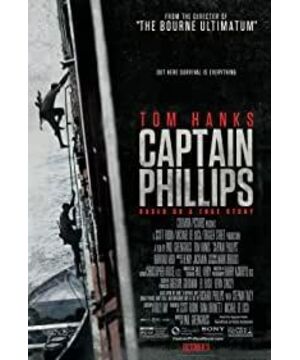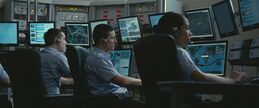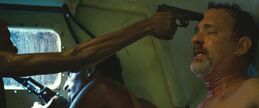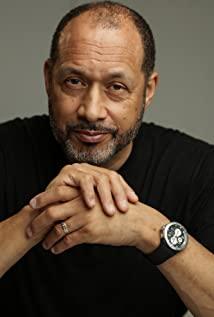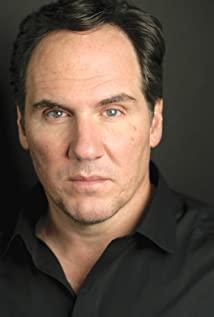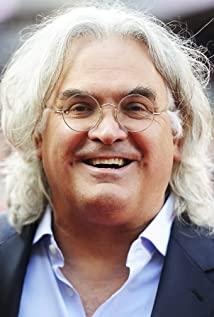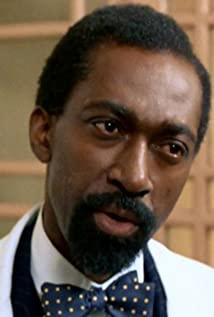"Captain Philip" is adapted from the USS Alabama hijacking case in 2009. This is the first time a US citizen has been kidnapped at sea in more than 200 years. The captain of the Alabama, Richard Phillips, who was hijacked by Somali pirates, was in a stalemate with the pirates for five days and five nights, and was finally rescued by the SEAL team. The following year Philip published the "Captain's Journal" detailing the entire hijacking process, and the Columbia company acquired the right to adapt the film and television in one fell swoop. The film structure is divided into two parts. The first half talks about how Captain Philip protects the cargo ship and crew and fights wits with Somali pirates. In the second half, the hero turns into a prisoner. This is the story of the rescue of Captain Philip. Such a real event attracts people's attention in real life, but as a movie, it lacks an expectation index, because the audience knows that Philip is bound to be saved and that justice triumphs over evil. Paul Greengrass, who has accumulated the accumulation of "Flight 93" and the best two "The Bourne Shadows", naturally knows this, and he has found the most suitable way out for this movie.
When Hollywood made a big push into the field of visual effects and true and false 3D attempts to dominate the screen, Paul Greengrass went the other way and chose to lead the crew on board for two months. Real warriors dared to face the real-life shooting at sea, coupled with untracked, full-hand-held documentary image style, fierce and fast-paced editing, and a strict isolation policy between the pirate team and the crew team. The two groups of men and horses staggered the shooting time, even Dining and staying are also different places, everything is to maximize the restoration of the scene of the Alabama hijacking. Tom Hanks laughed to the investigative reporter: "I didn't eat dinner together at the boot. The first time I saw them was through the binoculars. People were already driving towards us in a speedboat." In order to realize the important scene of the boarding and hijacking, The director arranged for four pirate actors with no acting experience to perform physical training months in advance, starting from swimming and sailing, until they can use their own skills to climb from a small speedboat to a huge ship, just like real pirates. This time-consuming and arduous method of making movies seems to be exclusive to Kurosawa Akira, who was waiting for the clouds in the last century, and Mr. Wang in sunglasses who had trained Zhang Zhen to become a Bajiquan champion. In today's industry environment where the return on investment ratio is most important and the first draft of the script is written before the marketing plan is released, Paul Greengrass' persistence is very rare. As the so-called smart people work stupidly, everything worked. Because of the truth, even the Alabama is alive. It faces the small and swift pirate boat, moving its huge body, helplessly tossing, and failing, which makes people worry.
Some viewers have higher expectations for the film, believing that Paul Greengrass did not dig deep into the root causes behind the Somali pirates, and did not completely break through the pattern of the American patriotism education propaganda film. All movies are framed paintings, even documentaries, what to do or not to shoot, the material cut in and thrown out is a choice in itself. From this point of view, "Captain Philip" is certainly not exempt from vulgarity, but the crude and simple classification of the film as a Gao Daquan, Wei Guangzheng American propaganda film really wronged it. In the movie, the pirates repeated "We are just fishermen" three or four times, from cunning to helpless to self-deprecating. Captain Philip was hijacked on a lifeboat. There were a few brief conversations with the pirate leader Muse, "I can't help it." , I have a boss above." "We all have a boss." Such a few words are enough in my opinion. You and I understand the world of implication.
In reality, Captain Philip himself frankly did not voluntarily sacrifice himself to save the crew, because "I was captured at the time", and said that the real hero is the SEAL Team 6 and all his crew. Calm and obedience to the command prevented the expansion of the tragedy. . According to CNN reports, the real situation that year was that most of the crew not only did not think Captain Philip was a hero, but eleven crew members filed a lawsuit of nearly 50 million dollars against Maersk Line, claiming that Captain Philip ignored the safety of the crew and saved the voyage. Cost, arbitrarily heading for dangerous waters, and all ships have been warned before sailing. The email as evidence did mention "please stay 600 nautical miles away from the Somali coastline." When the Alabama was attacked by pirates, it was only 380 miles away from the Somali coastline. Mike Perry, Chief Mechanic of the Alabama, said: "We are all sad, but the publicity campaign surprised us. He was directly responsible for the pirate attack." In the 2012 evidence collection, Captain Philip admitted that he had received it. Maritime Safety Agency’s mail, but he claimed: “I don’t think 600 nautical miles can guarantee any safety, I don’t think 1200 nautical miles can guarantee any safety, just like I said to other crew members at the time, we have been on this route. (Pirate problem) It’s just a matter of time. I don’t think that a distance of 600 nautical miles will reduce the potential danger." The truth of the crisis must not be black and white. The New York Post reported that Sony paid five thousand dollars per person for the crew. Signed an agreement to buy the copyright of their story, and agreed that the true situation on board at that time should never be disclosed. So as the audience, on the channel leading to reality, everyone can only get a glimpse of the waves of the time from the framed paintings.
Although Captain Philip never considers himself a hero, he is still known to the public as a hero. The 57-year-old Tom Hanks wants to learn more from his daily life and spends several weeks investigating and searching for information. When meeting the real captain, Tom Hanks said that when he met Captain Philip for the first time, he still naively asked: "'You must like looking at the sea very much.', but he said that I have been there for thirty-five years. I haven't done this before. I want to master such details." I don't want to have a poetic touch to life on the sea, let alone romanticize a captain's work routine lightly. In the live shooting at sea, the director said that Hanks was always full of praise: "After spending several hours on the lifeboat, everyone was inspired by him. Even if the seasickness gets worse, Tom is always the first to turn around and say' I can do it again."" If all of the above is expected, (Who called him a model of Hollywood, Germany and Art?) Then Tom Hanks was in the last half of "Captain Phillip" The hours of performance really conquered me.
The last scene of Philip’s rescue that can be recorded in film history is not in the script. It is because the captain of the destroyer Bainbridge and the naval medics have been shooting with him. Paul Greengrass had an idea and asked the medical staff to follow Captain Philip. The routine checkup when rescued was given to Tom Hanks from the beginning. At this year's New York Film Festival, Tom Hanks recalled that scene and still couldn't help but sigh "It was like I had never made a movie at that moment." There is no two-time Oscar winner, just a 57-year-old ordinary American man, a husband who discussed the future of his child with his wife before leaving, and an old captain who was slightly staid and serious in running with the crew below, because he was extremely tired and dangerous. The post-traumatic syndrome brought by him, his trembling, trance, and fragility happened in this way. Captain Philip is not a superhero at all, he is just and should be just an ordinary person in extraordinary circumstances. I am really moved by Hanks's moment of letting go. I thought he could not give more surprises to the fans who love him, because he is already at the top. Like the last moment of a martial arts master, Tom Hanks in this film has spent his life training, returned to the basics, and arrived in the state of no self.
Director Paul Greengrastam said that the first few intentions were unsuccessful. The old partner photographer Barry Ackroyd even got the first one in the wrong position (he was also the photographer of "Flight 93" and "The Hurt Locker"), so He and Tom Hanks walked out the door and talked, "This is how a great actor is. When he sees a door, even if there is only a gap, he will bravely walk through it to find the truth after each scene. A lot. People shared with me the feelings of shocking the soul and humanity when I saw the end of the movie. What I saw was a great actor looking for the truth." I
thought that such a precise high comment could crown the entire "Captain Philip" crew. In the huge wave of technological innovation in movie special effects, there is still such a group of people driving a small boat to move forward, approaching reality with real power.
Finally, I also like the narrative subtitles at the end of the film: In 2010, Philip went back to the sea.
The captain, of course, belongs to the sea.
(Already published in "Global Screen")
View more about Captain Phillips reviews


